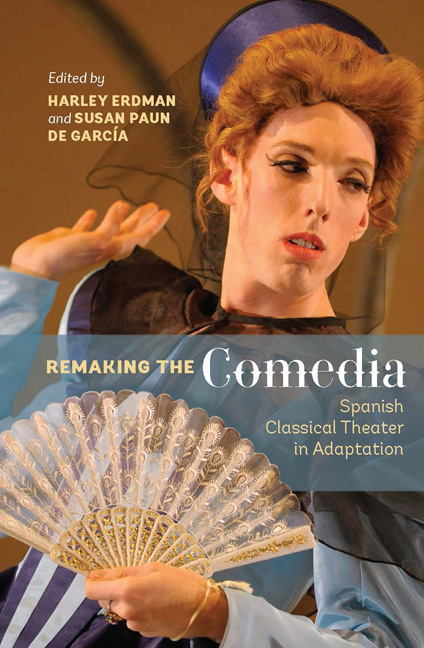Book contents
- Frontmatter
- Contents
- Illustrations
- Contributors
- Preface
- Note to the Reader
- Acknowledgements
- PART I THEORIZING
- PART II SURVEYING
- PART III SPOTLIGHTING
- PART IV SHIFTING
- 21 Porous Boundaries: novela or comedia?
- 22 Lope de Vega and Lenfilm: The Dog in the Manger's Cross-Cultural Journey
- 23 Classical Theater and Puppetry: La Máquina Real
- 24 Remaking Moreto's El desdén con el desdén: From Author's Text to Director's Text
- 25 Lope's Peribáñez on the Lyric Stage
- 26 A Musical Marta
- Play Titles Cited
- Works Cited
- Index
21 - Porous Boundaries: novela or comedia?
from PART IV - SHIFTING
Published online by Cambridge University Press: 05 December 2015
- Frontmatter
- Contents
- Illustrations
- Contributors
- Preface
- Note to the Reader
- Acknowledgements
- PART I THEORIZING
- PART II SURVEYING
- PART III SPOTLIGHTING
- PART IV SHIFTING
- 21 Porous Boundaries: novela or comedia?
- 22 Lope de Vega and Lenfilm: The Dog in the Manger's Cross-Cultural Journey
- 23 Classical Theater and Puppetry: La Máquina Real
- 24 Remaking Moreto's El desdén con el desdén: From Author's Text to Director's Text
- 25 Lope's Peribáñez on the Lyric Stage
- 26 A Musical Marta
- Play Titles Cited
- Works Cited
- Index
Summary
Adaptation has commonly been understood as an act of modifying, reworking, updating, re-envisioning, or re-interpreting a previously written text with the end purpose of performing a new version on the stage. however, the terms “adaptation” and “remake” also suggest a change of genre, such as a transposition of a novel or story to a play or movie, or in the other direction, a “novelization” of a popular film or TV series. We might assume that this move between text and performance is a recent phenomenon, or that genre boundaries were more firmly established in the past. Of course, this is far from the case. A look at early modern theory and practice will tell us that trans- or cross-generic adaptations were as common in Spain's seventeenth century as they are today. Both plays and novelas (especially the novela cortesana or “courtly novella”) absorbed and adapted the same sources, used similar techniques, and enjoyed tremendous popularity with the same audiences, just as film adaptations of books or novelizations of films do today. Furthermore, both genres were consumed as texts to be read, and both were performed in public. In fact, if we scrutinize the written word of both the prose narrative and the written text (not the performance text) of a comedia we will find, as Florence yudin has maintained (“Novela”), more similarities than differences, especially if we admit the possibility, approaching probability, that many prose narratives were read aloud and therefore “performed.” In the end, both were created for the competencies and sensibilities of a receptive and consuming public familiar with both–an audience that could bridge the differences between them.
Often adaptation studies begin and end with questions of fidelity to the source (with priority given to whatever came first), making the main purpose of the comparison to determine the success of the adaptation in conveying the core meanings and values of the source. While contemporary studies have moved beyond a discussion of essence and fidelity, they are geared towards modern consumers, based on the assumption that, whatever the form, adaptations will mostly be seen (or read) by an audience with no previous contact with the source.
- Type
- Chapter
- Information
- Remaking the ComediaSpanish Classical Theater in Adaptation, pp. 211 - 218Publisher: Boydell & BrewerPrint publication year: 2015

